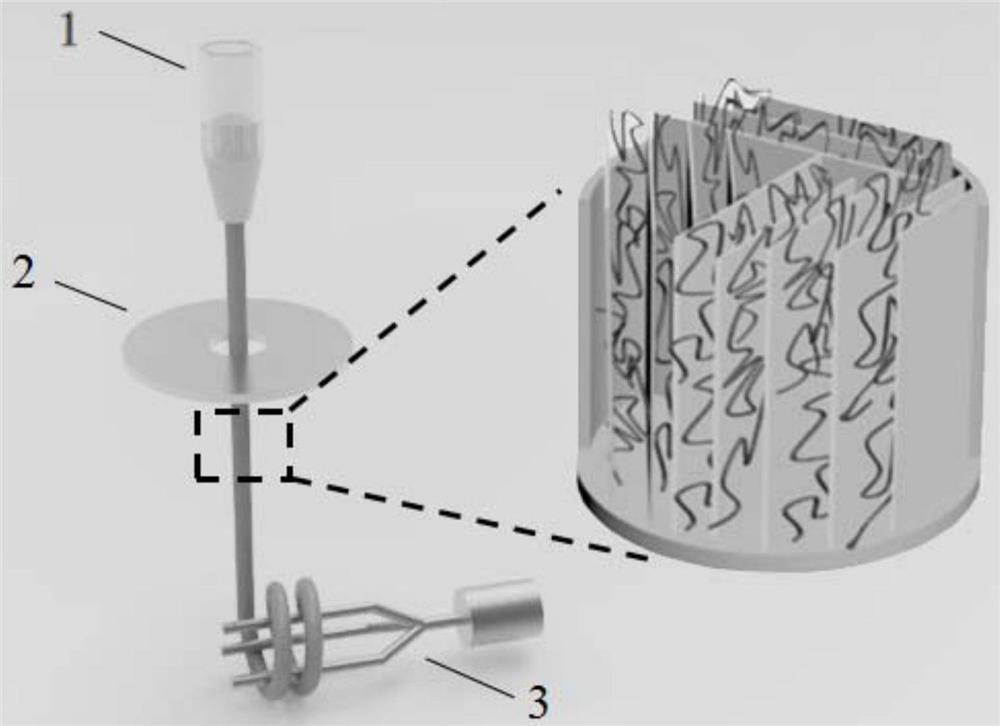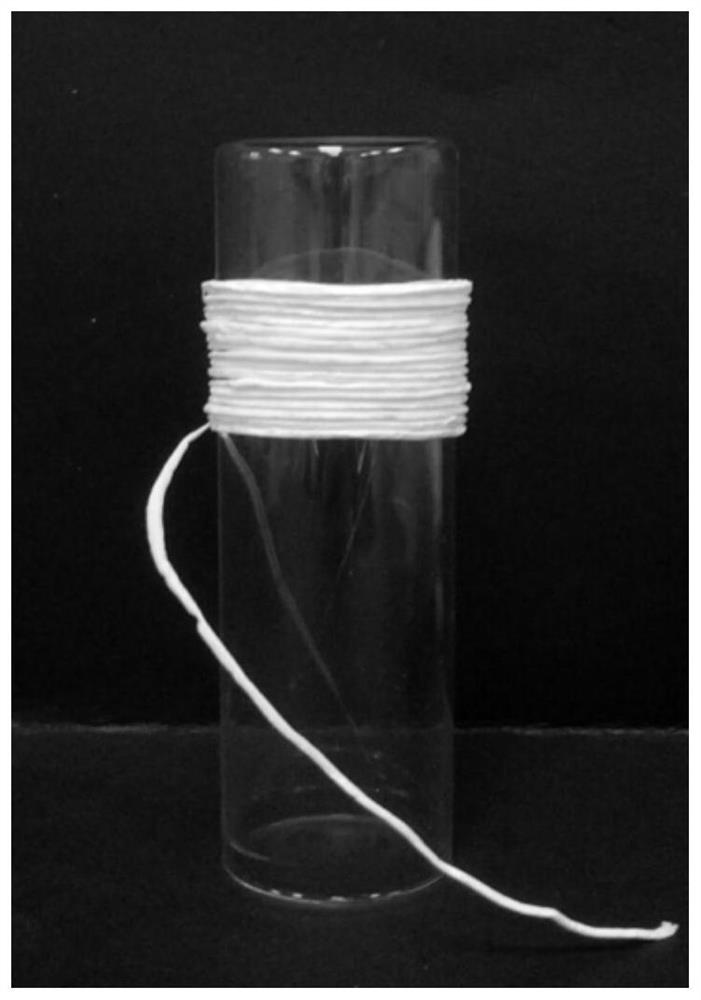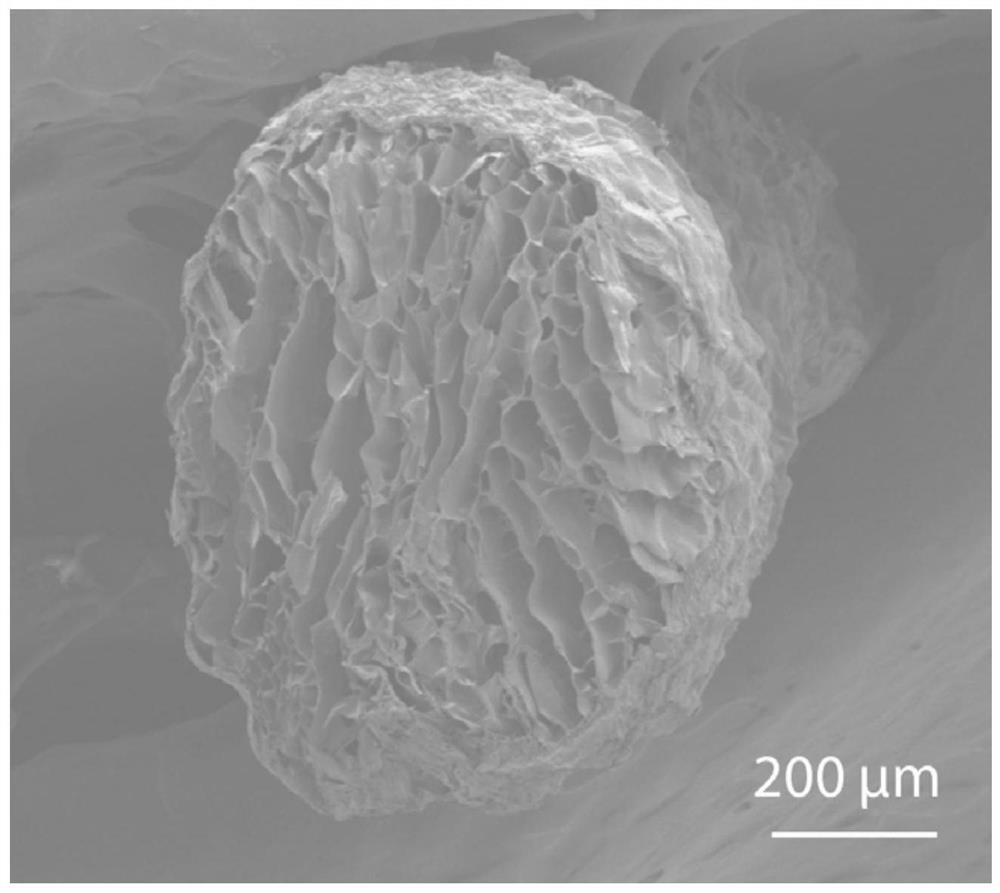Preparation method, product and application of UV-resistant porous fiber with oriented pore structure
A technology of porous fibers and pore structures, which is applied in the field of preparation of ultraviolet-proof porous fibers, can solve the problems of limiting the application of porous fibers, unable to realize continuous large-scale preparation, etc., and achieves the effect of a simple preparation method.
- Summary
- Abstract
- Description
- Claims
- Application Information
AI Technical Summary
Problems solved by technology
Method used
Image
Examples
Embodiment 1
[0083] (1) Cut 4.5g of natural cocoons, boil and dry in 1% sodium carbonate solution, dissolve in 20ml of 9mol / ml lithium bromide solution, and dialyze for 24h to prepare a 22.5% silk protein solution.
[0084] Dissolve 0.5 g of chitosan powder in 10 ml of 1% acetic acid solution, stir for 30 min at a speed of 800 rpm / min to make it evenly mixed, and prepare a chitosan solution with a concentration of 50 mg / ml.
[0085] Mix 20ml of silk protein solution and 10ml of chitosan solution evenly, and centrifuge to remove air bubbles to obtain a homogeneous solution, wherein the mass ratio of silk protein to chitosan is 9:1.
[0086] Mix the ultraviolet shielding agent titanium dioxide nanoparticles with the above mixed solution in a mass ratio of 100:1 between silk protein and titanium dioxide.
[0087] (2) Put the mixed solution in the syringe, extrude the solution through the extrusion pump, place the copper ring in a low-temperature reaction bath (-100°C), and pass the solution t...
Embodiment 2
[0094](1) Cut 4.5g of natural cocoons, boil and dry in 1% sodium carbonate solution, dissolve in 20ml of 9mol / ml lithium bromide solution, and dialyze for 24h to prepare a 22.5% silk protein solution.
[0095] Dissolve 0.5 g of chitosan powder in 10 ml of 1% acetic acid solution, stir for 30 min at a speed of 800 rpm / min to make it evenly mixed, and prepare a chitosan solution with a concentration of 50 mg / ml.
[0096] After mixing 20ml of silk protein solution and 10ml of chitosan solution evenly, centrifuge to remove air bubbles to obtain a homogeneous solution, wherein the mass ratio of silk protein and chitosan is 9:1.
[0097] Mix the ultraviolet shielding agent zinc oxide nanoparticles with the above mixed solution at a mass ratio of 200:1 between silk protein and zinc oxide.
[0098] (2) Put the mixed solution in the syringe, extrude the solution through the extrusion pump, place the copper ring in a low temperature reaction bath (-30, -60, -90°C respectively), and pass...
Embodiment 3
[0103] (1) Cut 4.5g of natural cocoons, boil and dry in 1% sodium carbonate solution, dissolve in 20ml of 9mol / ml lithium bromide solution, and dialyze for 24h to prepare a 22.5% silk protein solution.
[0104] Dissolve 0.5 g of chitosan powder in 10 ml of 1% acetic acid solution, stir for 30 min at a speed of 800 rpm / min to make it evenly mixed, and prepare a chitosan solution with a concentration of 50 mg / ml.
[0105] After mixing 20ml of silk protein solution and 10ml of chitosan solution evenly, centrifuge to remove air bubbles to obtain a homogeneous solution, wherein the mass ratio of silk protein to chitosan is 9:1.
[0106] Mix the ultraviolet shielding agent organic nickel polymer with the above mixed solution at a mass ratio of 300:1 between silk protein and organic nickel polymer.
[0107] (2) Put the mixed solution in the syringe, extrude the solution through the extrusion pump, place the copper ring in a low-temperature reaction bath (the temperature is -100°C), p...
PUM
| Property | Measurement | Unit |
|---|---|---|
| concentration | aaaaa | aaaaa |
| diameter | aaaaa | aaaaa |
| pore size | aaaaa | aaaaa |
Abstract
Description
Claims
Application Information
 Login to View More
Login to View More - R&D
- Intellectual Property
- Life Sciences
- Materials
- Tech Scout
- Unparalleled Data Quality
- Higher Quality Content
- 60% Fewer Hallucinations
Browse by: Latest US Patents, China's latest patents, Technical Efficacy Thesaurus, Application Domain, Technology Topic, Popular Technical Reports.
© 2025 PatSnap. All rights reserved.Legal|Privacy policy|Modern Slavery Act Transparency Statement|Sitemap|About US| Contact US: help@patsnap.com



